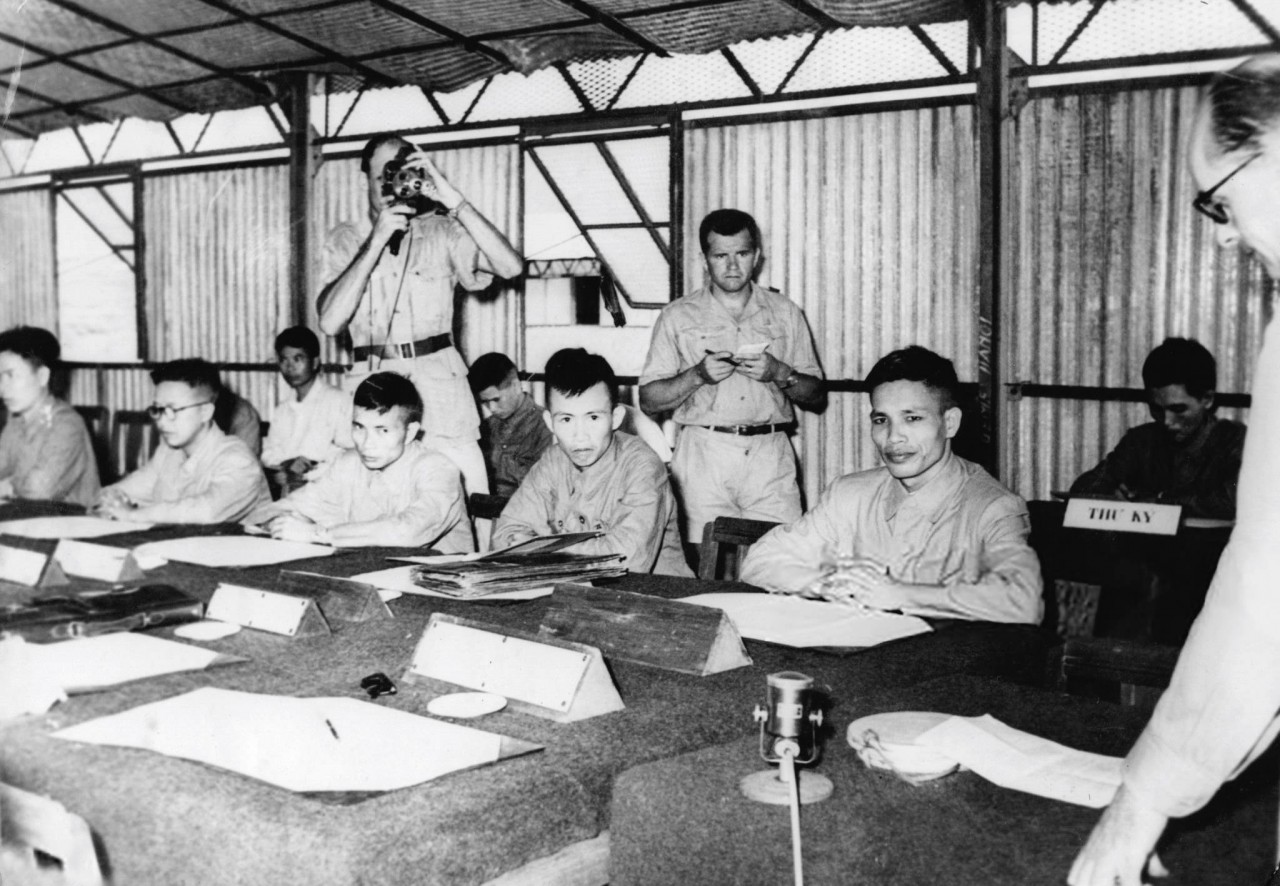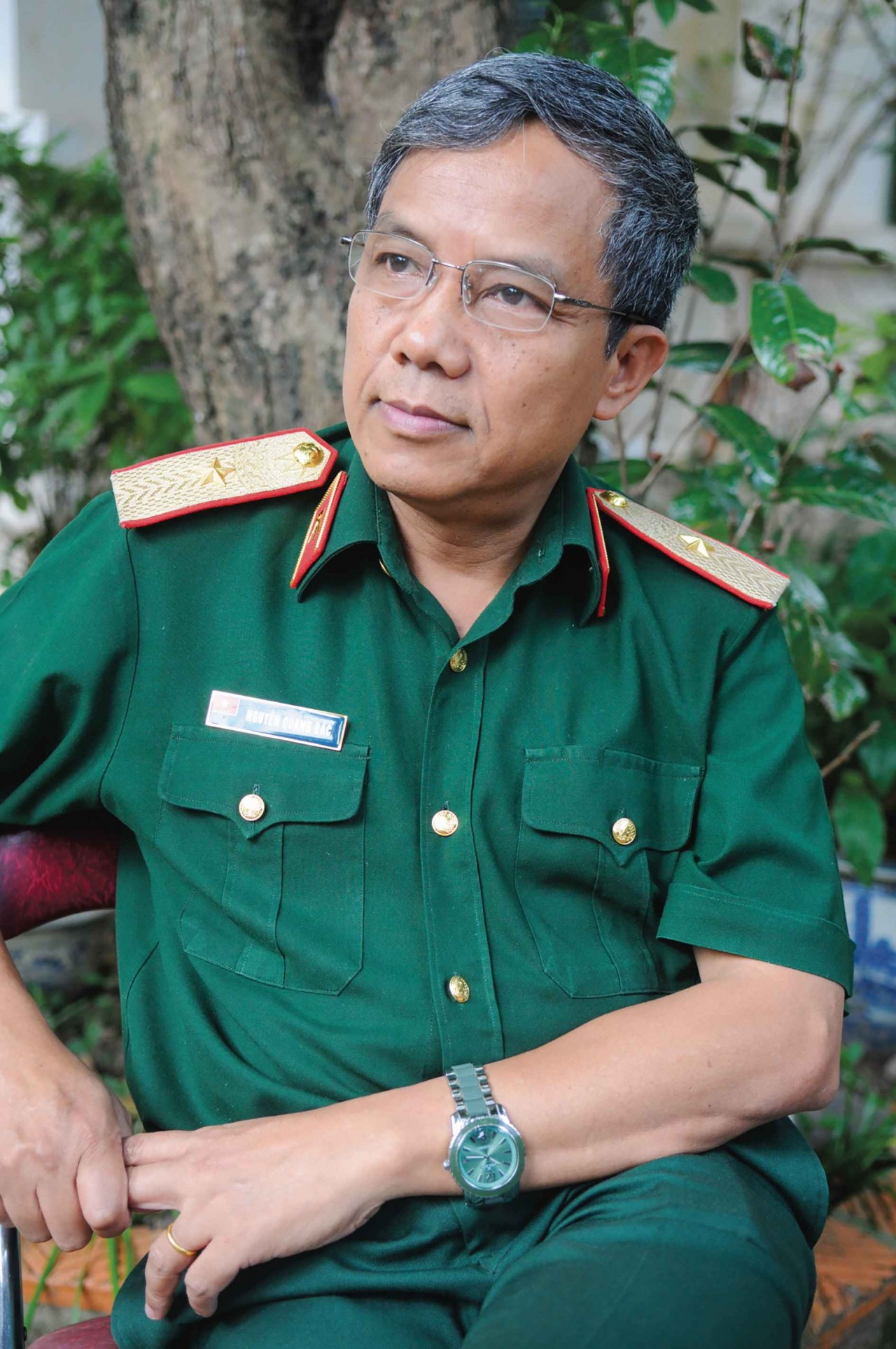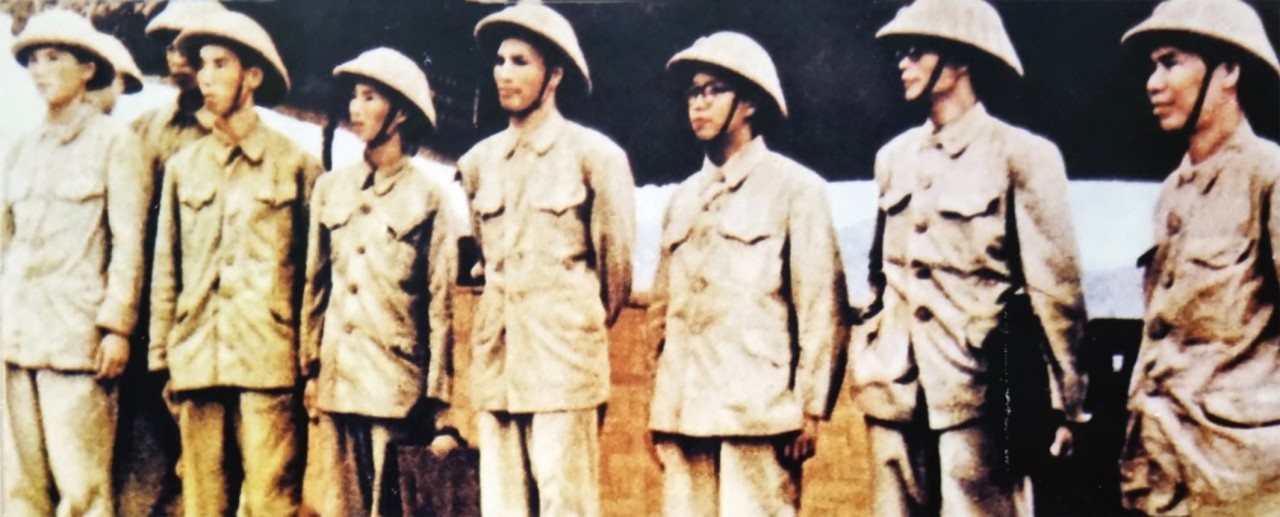
Trung Gia Military Conference: Another Geneva Conference in Vietnam
Latest
 |
| Chief of the General Staff Van Tien Dung (far right), Head of the delegation of the General Staff of the Vietnam People’s Army at the Trung Gia Military Conference, July 1954. |
Implementation of the Geneva Agreements
Enforcing the agreement of May 17, 1954 between the head of the French delegation and the Head of the Vietnamese delegation at the Geneva Conference, the 8th session of May 29 approved that representatives of the General Staff of the Vietnam People’s Army and General Command of the French Union Forces in Indochina meet both in Vietnam and Geneva to discuss the arrangement of military forces according to the ceasefire agreement, starting with the demarcation of troop concentrations of both sides in Vietnam.
The Vietnamese military delegation included: Major General Van Tien Dung, Chief of the General Staff, as the Head of the delegation; Colonel Song Hào (Political Commissar of the 308th Division), Deputy Head; Colonel Le Quang Dao (Director General, Department of Publicity and Education); Lieutenant Colonel Nguyen Van Long (Department of Operations); Lieutenant Colonel Le Minh (a.k.a Le Minh Nghia - Department of Military Political Training and Public Affairs); and Nguyen Van Le (a.k.a Luu Van Loi) as the interpreter.
 |
| Doctor of Science, Major General Nguyen Quang Bac. |
Responsible for the delegation’s publicity and media, as well as a group of 10 Vietnamese journalist are Dao Tung and Hong Ha, respectively. The French military delegation comprised Colonel Paul Lennuyex as the Head of the delegation, four French officers, and three Vietnamese officers representing three battlefields under the government of Bao Dai.
The Trung Gia Military Conference took place in Trung Gia commune, Da Phuc District, Phuc Yen province from July 4 to July 27, 1954, focusing on measures to cease hostilities in the Vietnamese battlefield and the issue of prisoner exchanges. The conference demonstrated the willingness of both sides to negotiate towards peace and had practical value through regular contact between Vietnamese and French representatives, both before and after the signing of the Geneva Agreement, to ensure timely implementation of the said agreement.
On July 20, 1954, the Geneva Agreement on the cessation of hostilities in Vietnam was signed.
On July 23, 1954, the General Staff of the VPA ordered a ceasefire in accordance with the Geneva Agreements. The ceasefire period was specified as follows: in the Northern region starting from 7 a.m. on July 27, 1954; in the Central region starting from 7 a.m. on August 1, 1954; and in the Southern region starting from 7 a.m. on August 11, 1954.
On July 27, 1954, a delegation of the General Staff of the Vietnam People’s Army went on the road to dissiminate the ceasefire orders to the battlefields. A group of the delegation went to Binh Tri Thien, of which, officers Tran Chi Hien, Ho Sy Than, Vu Ky Lan landed on Dong Ha airport. Another group went to the Southern Region, consisting of Do Duc Kien and Nguyen Van Long, among others. They splitted into two: one landed on to Soc Trang airport and went to the Western base, the other arrived at Dau Tieng airport and headed East.
On their way south from Ha Noi, a group of officers stopped in Quy Nhon to pick up several officials, including Le Duan who was to provide guidance for the Southern Party Committee in redirecting the struggle in the new phase. On August 7, a group departed from Gia Lam airport to Xieng Khoang (Laos), led by Dang Tinh, Deputy Director General of the Department of Operations (consisted of 45 people). Another group headed by Nguyen Thanh Son departed to Cambodia on August 11. Before embarking on their mission, Deputy Chief of General Staff Hoang Van Thai met with all the groups to provide instructions and specific tasks. All delegations, tasked with conveying the ceasefire orders from the battlefields, traveled by French aircraft, per the agreement reached between us and France at the Trung Gia Conference during the session on July 25, 1954. Additionally, France agreed to assist us by transporting (using French aircraft displaying Vietnamese flag) our officers to disseminate President Ho Chi Minh’s directives, operational orders, and ceasefire orders from the Ministry of National Defense to remote areas in Military Region V and the Southern region, from July 31 to August 2, 1954.
Exchange of prisoners
At the end of July, Vietnam and France agreed to establish the Central Joint Commission. On July 27, 1954, Commander-in-Chief Vo Nguyen Giap signed the appointment letter for the VPA delegation to the Central Joint Commission, comprising members from the Trung Gia Conference. Lieutenant Colonel Nguyen Van Long was replaced by Major Dong Van Cong (representing the Southern region), and Lieutenant Ho Xuan Anh (also known as Hoang Anh Tuan, representing the Central region) was added. Major General Van Tien Dung led the delegation, with Colonel Song Hao and Colonel Le Quang Dao as deputies. The French delegation was led by Brigadier General Henri Delteil, with Colonel Lennuyeux as Deputy. The General Staff of the Vietnam People’s Army established a monitoring team, led by the Chief of the Operations Department Tran Van Quang, to report on the activities of the Commission and receive directives from the Commander-in-Chief regarding the Vietnamese delegation.
 |
On July 29, the Central Joint Commission began its work in Trung Gia and addressed issues raised by the Geneva Conference, such as prisoner exchanges, establishing non-military zones, prohibiting the introduction of new weapons into Vietnam, and the transfer of troops from both sides. Vietnam assumed control of Ha Noi and the Hai Phong area. In early August 1954, the Joint Commission relocated to Phu Lo, near the Ca Lo River, as French troops withdrew from Ha Noi and shifted towards Bac Ninh.
August 14 to September 4, 1954, the signing and implementation of the agreement for the exchange of prisoners of war took place. On August 17, the two delegations exchanged lists of prisoners of war. We handed over General De Castries on September 3. On September 4, 1954, both sides completed the exchange of POWs. We returned a total of 10,173 individuals to France, including 9,247 African POWs, among them one general, 55 colonels, 500 lieutenants and 3,523 corporals. France sent us 68,251 individuals (8,872 servicemen)
Intense struggle
This is the result of a very intense struggle between us and France at the Central Joint Commission. Upon receiving the list of POWs the French side, along with the exact lists of Vietnamese detained by the French provided by our provinces, the Vietnamese delegation fought to exposed the French’s lack of goodwill in not wanting to return all of our people, especially those they deemed important. We demanded that France promptly add more names to the list of individuals to be exchanged.
During a meeting of the Central Joint Commission on the issue of prisoner exchanges (at the end of August), Major General Van Tien Dung said to the French delegation: “We do not want or need to keep any of your people, but do not expect to receive your own people while you continue to detain our comrades.” Nonetheless, at the end of the exchange, we still returned all prisoners of war and those detained by us, even though we knew France would not reciprocate.
The Trung Gia Conference discussed measures to implement the ceasefire, a tremendously difficult task given the battlefields were intertwined, with no clear front lines, while also ensuring the timely assembly of military forces and government bodies. Within two months from the opening day of the conference (July 4th - September 4th, 1954), both sides successfully completed the exchange of tens of thousands of prisoners of war and detainees. Thus, the Trung Gia Conference truly facilitated the rapid and timely implementation of the Geneva Agreement, contributing to the success of the Geneva Conference and the restoration of peace in Vietnam.












